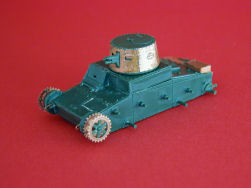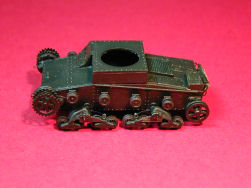
Unimodel 1/72 Vickers “E” Mk.B Build Review
By Llarry Amrose
| Date of Review | December 2011 | Manufacturer | Unimodel |
|---|---|---|---|
| Subject | Vickers “E” Mk.B | Scale | 1/72 |
| Kit Number | 0619 | Primary Media | Styrene/PE |
| Pros | Unusual subject | Cons | Thick photoetched brass |
| Skill Level | Basic | MSRP (USD) | $12.50 |
Background
The Vickers Mark E 6-Ton tank was designed in 1928 in the United Kingdom, and while not accepted into British service, would end up being one of the most widely used and copied designs of the Thirties and into World War II.
The Mark E was built as a private project by Vickers-Armstrong, designed by a group led by the renowned team of John Valentine Carden and Vivian Loyd. Later the pair would create such designs as the Light Tank Mk.VI and a prototype of the famed “Bren Carrier”.
Two versions were built, one, Mk.A, with two small turrets each with a single machine gun, and the Mk.B with a single turret mounting a 47mm cannon for fire support. The two-man design of the Mk.B turret was revolutionary, the division of labor serving to increase rate of fire, and featuring in almost all later tanks, leading eventually even to three-man turret crews.
The suspension may be the most recognizable feature of the Mark E and its descendants. It consisted of two axles, each of which carried a pair of two-bogie units connected by a leaf spring. This system gave good cross-country performance, even if not quite up to the standard of the Christie suspension (basis for the BT-7 and T-34).
When Britain only purchased 4 machines for training purposes, Vickers looked for foreign customers, eventually selling tanks to 10 nations, and production licenses to two of those. Poland used their license to develop the 7TP series of light tanks that they started WWII with. The USSR made even better use of the license, developing the T-26 series, in multiple configurations and even including specialized engineer vehicles, with a total production of over 12,000 tanks. After meeting the T-26 during the Spanish Civil War, Italy used captured examples as the basis for their Fiat-Ansaldo M11/39 and M13/40 tanks and the Semovente self-propelled gun.
The Kit
UM has made kits of the T-26 and its variants for some time, but now they have released the Vickers Mark E which was the source of the design. Some years ago, Mirage produced the single- and double-turret Mark E as well as both versions of the Polish 7TP, but they are harder to find now.
Inside UM’s standard end-opening box are 3 sprues of dark green plastic and two in silvery-grey. Sprue A comprises the suspension, and B is the hull. These sprues trace their lineage back to the Skif T-26 kit, but appear to still be in good shape. Sprue D is the turret. Two copies of C, in grey, make up the link and length tracks. These are also available separately from UM – I used a set on my Italeri Semovente. Finally there are two frets of photoetched metal; E contains hull and suspension details while F is specifically for the turret. Usually, UM’s metal parts are thick and rigid and pretty much require heat treating to be pliable enough to shape as needed. These appear to be more copper than brass and are soft enough to be used straight from the box. There are no decals.
Assembly
The instructions consist of 17 steps, though a fair number of those are small subassemblies. They have you begin with the lower hull and then the suspension, though certainly the turret can be built separately at any convenient point.
In step three, the drive sprockets are assembled, and in a manner I’ve never seen before. There’s a plastic center and spokes, but the teeth are metal. This makes them more like true scale thickness, though it will mean using CA or epoxy to mount the track links. Steps 5 and 6 build up the suspension units. There are four of them and they are not “handed” so watch out for part 8A, the axle cover. The instructions show it mounting in one place, but actually on two of the units it will need to go on the opposite side. Take a good look at step seven to see how the units get mounted.
Step ten may be the busiest, adding the upper hull, and the tracks, and the fenders. I recommend building the upper hull and getting it all cleaned up and then painting. (In fact you might want to do this before adding the suspension back in seven.) At that point you can mount the tracks, leaving the fenders for last. The tracks are link and length, and go together well, but can be a little tricky. If you’ve never built link and length tracks before, you might want to get at least one easier build, such as one of UM’s T-34s, under your belt first. The fit is good; the trickiest part of this set of tracks is that the pieces are fragile. You need to be careful removing them from the sprues. Fortunately there are a few extra single links to work with.
Once the fenders are in place, there are just a few pieces remaining, mainly photoetched details such as fender brackets and the headlight mountings from step eleven.
The turret is one of the most striking parts of this kit. The conical structure mounts to the turret ring, but then the sides are covered with sheets of metal, making up the riveted armor. Piece 67F snugs up nicely against a view port, and then you can proceed counterclockwise with the other three plates. The metal parts are sufficiently flexible to shape and install. Then the gun, built up in the previous two steps can be mounted. It looks so nice at this point, it’s almost a shame to have to paint it.
Painting and Finishing
There’s only one paint scheme, as this kit represents a vehicle primarily produced for export. The paint reference is for Humbrol 30 Dark Green. While this is a reasonable match for the color depicted on the box, the information I’ve seen indicates that British tanks before 1938 were most likely to be in Bronze Green, which is much darker.
There are no decals, and weathering was kept light as befitting a peacetime vehicle.
Conclusions
All in all, an enjoyable and recommended build. The kit goes together quite well and appears quite accurate. I have seen reviews of UM’s Vickerss that include some criticisms of some of the details, though generally such that only the true Vickers fanatics will be concerned. On the other hand, the separate tools, openable hatches, variety of spare parts on the sprues, and the photoetched track return skids are fine features. The forms for bending the metal parts have gone into a drawer in my workbench for future use with other kits.
There are a few fairly complex parts to this kit, particularly the suspension. Between that and the link and length tracks, I would only recommend this once you have a couple of other short-run kits under your belt. The metal armor for the turret is especially effective, and the result is a very nice kit of an important vehicle.
My thanks for the kit to HobbyTerra.





















